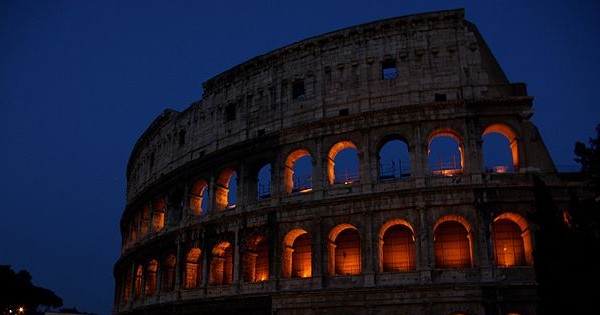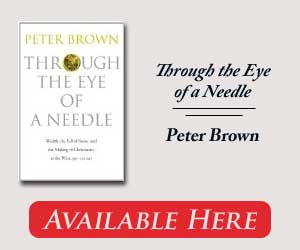
Through the Eye of a Needle: Wealth, the Fall of Rome, and the Making of Christianity in the West, 350–550 AD, By Peter Brown, Princeton University Press, 806 pp., $39.95
When the renowned historian of late antiquity Peter Brown confesses in a preface that this has been his most difficult book to write, ever—though the topic is at the center of the field he more or less created—a reviewer naturally wonders why.
To be sure, Brown has provided an unprecedented resource that deserves some appreciation. Through the Eye of a Needle (the title refers to Matthew 19:21–26, in which Jesus teaches that it is unimaginably difficult, but not impossible, for the rich to be saved) leaves out practically nothing important about the Western Christian churches’ evolving relationship to material wealth during the crucial period (longer than indicated in the subtitle) from the Roman Emperor Constantine’s conversion to Christianity in 312 A.D. until well after the churches’ emergence as the leading institutions in Europe. (I use the plural, “churches,” because in this era, when Catholicism was still consolidating itself, these institutions were local and distinct.) Drawing on decades’ worth of expertise in writing and speaking to both scholars and the public, Brown creates broad, deep landscapes in which the reader can watch the ancients moving. You can, in places, just crawl in and have a true dream about the ancient world.
Moreover, the topic holds fascinating implications about the formation of modern Western culture. In ancient Greece and Rome, the wealthy traditionally engaged in civic giving, chiefly for public buildings and entertainments. The Christian churches managed to harness the sentiments, but with a critical difference: everyone, down to a community’s humblest member—and no one was too humble to be excluded from Christianity—was expected to give what he or she could. Also, help for the needy verged from the main pagan precedent of allotments to citizens alone. Those with nothing now had an ipso facto call on the pious and respectable, those with more than they needed an ipso facto duty to give.
Monasticism and other sweeping material sacrifices in the name of an increasingly powerful and influential religion helped break down the ancient pagan belief that anyone important must also be materially secure and independent, if not wealthy. Basic ideology was also changing in that “laying up treasure in heaven” (instead of buying dependence and influence, leading to a proportional material payback on earth) was the new rationale for letting go of riches. But in time, wealthy people were absorbed into the churches’ program without being asked to part with uncomfortable amounts of their goods. Radical sermons gave way to gen- tler ones, particularly as the churches themselves became rich and needed to justify this.
It’s a significant and suggestive story. The prob- lem, sometimes, is getting to the story through citations that yield footnotes and bibliography of nearly 200 pages (almost a quarter of the book, excluding the index) and innumerable qualifications based on secondary literature. I gravely doubt that readers outside Brown’s own field will, as he hopes, perceive “behind the cramped list of titles” any of his own “excitement” about “each of them.” On the contrary, most people would be perplexed—and perhaps irritated—by his attitude toward this “explosion” of late-antique studies. You don’t try to “keep up-to-date” with an explosion; you take cover, wait until the debris has ceased flying, and then come out and carefully consider what to pay attention to.
 As a translator of pagan texts with a growing interest in early Christian and ancient Hebrew ones—that is, someone always looking for a better historical sense of my authors and their subject matter, to compensate for narrow language and literary training—I struggle between praising Through the Eye extravagantly and quoting the little girl in the anecdote who reported, “This book told me more about penguins than I wanted to know.” How would someone react who just wanted to learn about late-antique Christianity from scratch? Actually, how would a graduate student use this book, sorting out which of its thousands of components might prove productive for her own work?
As a translator of pagan texts with a growing interest in early Christian and ancient Hebrew ones—that is, someone always looking for a better historical sense of my authors and their subject matter, to compensate for narrow language and literary training—I struggle between praising Through the Eye extravagantly and quoting the little girl in the anecdote who reported, “This book told me more about penguins than I wanted to know.” How would someone react who just wanted to learn about late-antique Christianity from scratch? Actually, how would a graduate student use this book, sorting out which of its thousands of components might prove productive for her own work?
Here is an example of the obstacles she would find. Using 22 footnotes, Brown first argues correctly but merely commonsensically that mercy and humanity, even toward slaves, were not unknown or unhonored among pagans. Citing one or two ancient authors would suffice as evidence; the existing dense network of authority is off-putting and— ironically—weak as rhetoric. (Part of what makes Gibbon’s Decline and Fall so delicious, despite its huge flaws, is its confidence, the learned author’s projection of himself as the unchallengeable expert on bigoted bishops and sensuous emperors. Surely Brown has more than earned the right to display a little of such salutary arrogance.)
He is, moreover, so badly whipsawed in this passage by reinterpretation-mad secondary sources that he contradicts his main point (here and in the whole book)—that distinct Christian attitudes and practices evolved. His assertions in the context of Constantine’s landmark law forbidding extreme cruelty to slaves left me flummoxed: “little ‘humanization’ ” occurred, and only for the “chilling reason” that the emperors wanted a monopoly on “savagery” toward slaves and lower-class free persons.
Brown then moves, bafflingly, to an example of Christian authorities formally challenging cruelty: “Despite these measures, violence between owners and their slaves continued. Around 300 [A.D.], the Christian bishops at the council of Elvira in southern Spain had to deal with cases of slaves who had died as a result of beatings ordered by their Christian mistress.”
In the pre-Christian era, no authority in the Roman world “had to deal” with any murder of a slave, however sadistic. Slaves, as property, were indistinguishable from inanimate objects where the “right to abuse” was concerned. As with the use of all other property in and around the Christian churches, an engrossing, stimulating story about our civilization exists. It should be easier for readers to find it.

